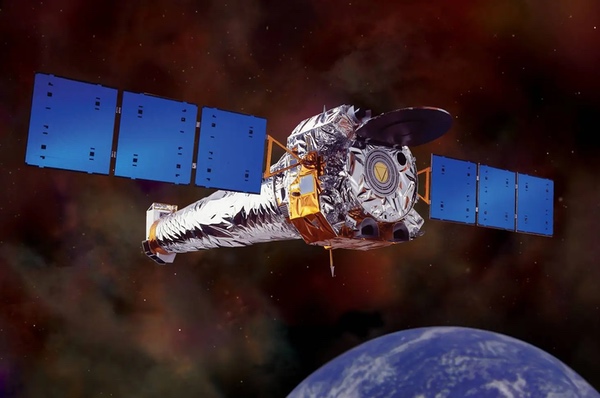NASA’s 2026 budget in brief: Unprecedented, unstrategic, and wastefulby Casey Dreier and Jack Kiraly
|
| This budget, if enacted, would not only abandon decades of American leadership in space science and exploration, but would also sabotage its own stated ambitions. |
The Planetary Society has spent the past two weeks closely reading this budget request, analyzing its numbers, and speaking with academics, industry representatives, and congressional staff. We have come to the conclusion that the FY 2026 budget is a deeply flawed document, formulated without the input of NASA or the stakeholders in the space community, that radically pivots the direction of the agency’s human spaceflight program while indiscriminately applying draconian cuts to science, aeronautics, STEM outreach, and space technology. It breaks the current consensus around Artemis, leaving the future of the lunar program relatively undefined after Artemis 3, proposing instead to spend billions of dollars on a rapid humans-to-Mars effort that is ill-defined, at best. It proposes cuts to infrastructure, science, and technology programs aligned with their stated goals, while also proposing large investments in duplicative commercial capabilities that are of questionable feasibility.
Ultimately, we believe this budget can be summed up in three words: unprecedented, unstrategic, and wasteful.
This budget, if enacted, would not only abandon decades of American leadership in space science and exploration, but would also sabotage its own stated ambitions, setting the nation’s space program on a path to political polarization, economic uncertainty, and surrender of the final frontier.
Unprecedented
Let’s be clear about the scale of this proposal. The request calls for a 25% cut to NASA in a single year; the largest single-year cut ever proposed by any White House for the agency. This cut eclipses even the post-Apollo drawdowns. When adjusted for inflation, this budget would shrink NASA’s buying power to a level not seen since fiscal year 1961 (which began in July of 1960), before the United States had even put a human in space, before anyone had gone into space.
 |
The proposal similarly decimates NASA’s workforce, the institutional knowledge and human capital that makes American leadership in space possible. It proposes severe layoffs at every NASA center, ranging from 20% to nearly 50% at Goddard Space Flight Center. No center is spared. The resulting civil servant workforce would be its smallest since fiscal year 1960. This will have real world impacts, as each NASA civil servant enables an average of 16 jobs in the overall space economy, and government spending has buoyed almost all of the growth in the space economy in recent years.
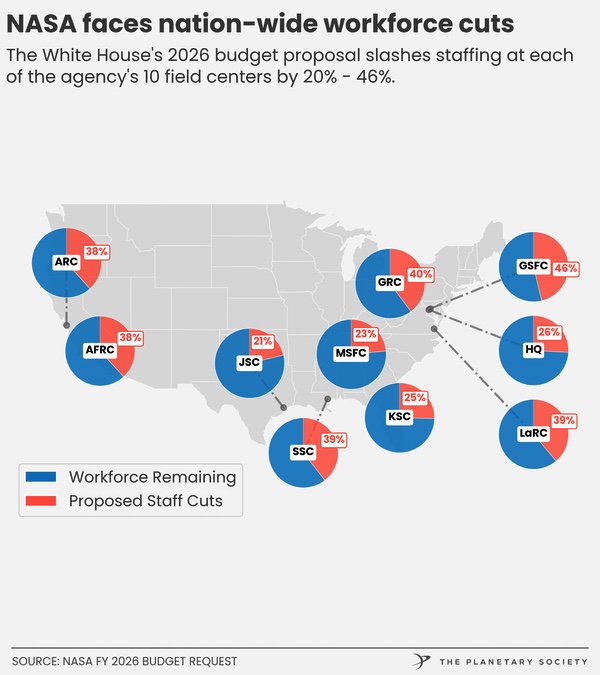 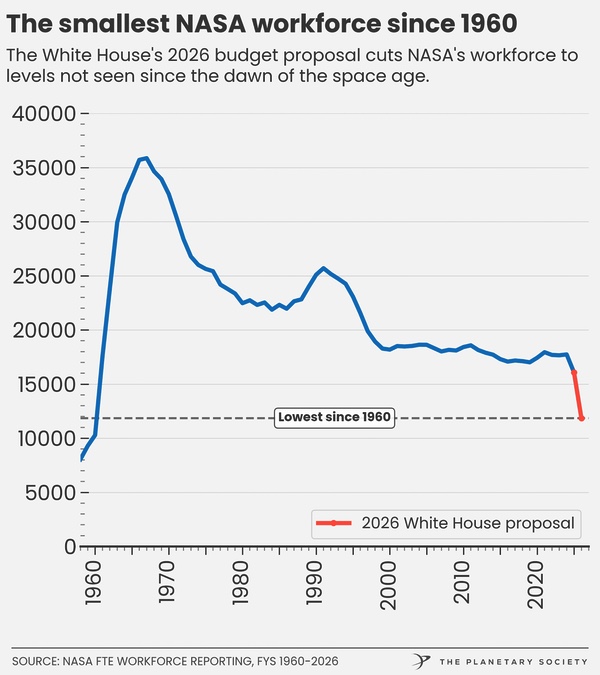 |
The irony is that these historic cuts are being proposed not as America winds down a lunar exploration program, but as the nation spins one up and begins the much more demanding task of sending humans to Mars. To ask NASA to undertake some of the most difficult engineering projects in world history while simultaneously slashing its resources and workforce to pre-human spaceflight levels is not just ambitious; it is fantasy, divorced from the realities of programmatic execution, economic conditions or fiscal requirements. It sets up the agency, and the nation’s space ambitions, for failure.
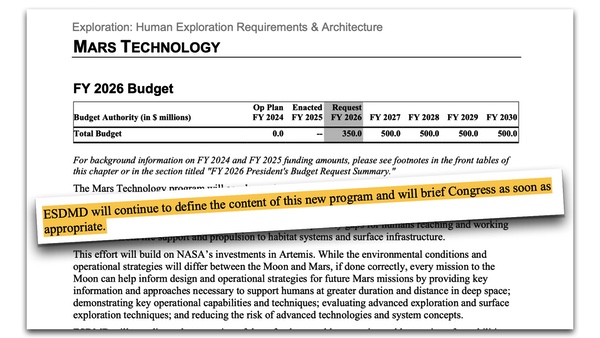 At numerous points the FY 2026 Budget Proposal requests hundreds of millions of dollars for programs that have no defined content or goals. If nothing else, this raises questions regarding if the amount requested is appropriate to enable the capability. This suggests a rushed process and a “budget-first” approach to program development. Both are ultimately wasteful of taxpayer dollars. Source: NASA FY 2026 Congressional Budget Justification, pg EXP-45. |
Unstrategic
A sound space policy is built on a strategy that aligns resources with national priorities and builds an enduring coalition to ensure its continuation into the future. This budget does the opposite.
The FY 2026 budget proposal is apparently the product of “budget-first” policymaking, driven by the Office of Management and Budget (OMB) with little, if any, meaningful consultation with NASA. Numbers were chosen arbitrarily, provided to the space agency, with the agency staff left to assemble a program within those limits. A notable parallel is the OMB’s arbitrary cap on Space Shuttle development costs, which forced NASA to adopt a compromised design that fell short of full usability, ultimately costing the nation billions more in operational costs. This budget is far more capricious, taking little, if any, input from NASA itself.
The numbers bear a suspicious resemblance to an ideological counter-proposal made years ago by the current OMB Director, Russ Vought, which called for a 50% cut to NASA Science; this budget proposes a 47% cut. This is not the outcome of a considered policy process. This budget request is the imposition of a predetermined number—not an expression of the President’s priorities, but those of the OMB Director’s.
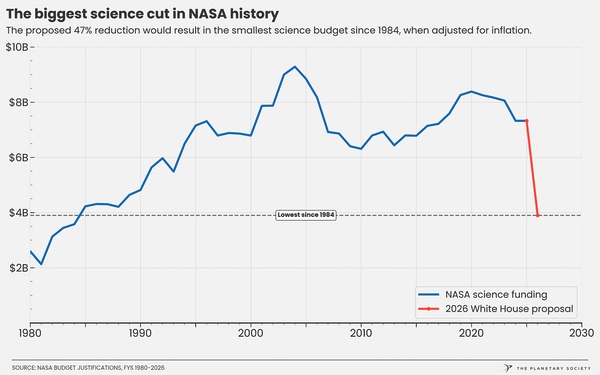 |
This lack of program strategy will directly undermine its own stated goals of sending humans to Mars by creating political division and enmity. In its rush to pivot, it divests from the very technologies and infrastructure essential for any future Martian expedition. It cancels the production of plutonium-238, the nuclear power source required for long-duration missions in the outer solar system, and used on surface missions for both power and heat. It proposes canceling active Mars telecommunications orbiters like MAVEN and Mars Odyssey—which provide vital telecom data relay for surface assets—in favor of a vague commercial replacement that does not exist and may not materialize for years. In so doing, it puts primary reliance of the remaining Mars rovers on the ESA-led Trace Gas Orbiter, a surprising choice given that this budget proposes to abandon nearly a dozen joint projects with the Europeans.
| Instead of building consensus, the budget destroys it by abandoning allies and commercial partnerships at the Moon, the wholesale destruction of key science, aeronautics, technology, and outreach activities. |
This proposal functionally cedes American leadership in space science to our geopolitical rivals. It pulls back from precisely the areas where China has announced it is moving forward: a Mars sample return mission, next generation space telescopes, and exploration of Venus and the outer solar system. By summarily canceling more than 40 active and future US science missions, including our contributions to joint projects with the European Space Agency like the Rosalind Franklin rover and EnVision Venus orbiter, we are not only abandoning the cause of exploration but also breaking faith with key international allies. The budget is a roadmap for how to abdicate leadership in the 21st century. China will be more than happy to pick up the mantle.
Furthermore, by proposing such divisive and destructive cuts, it sabotages its own long-term goals, politically. Instead of building consensus, the budget destroys it by abandoning allies and commercial partnerships at the Moon, the wholesale destruction of key science, aeronautics, technology, and outreach activities.
Wasteful
Ultimately, the most tragic outcome of this budget is the sheer waste it would generate. It is wasteful of taxpayers’ investment, of scientific progress, and of political capital.
Consider the Artemis program. For the first time in American history, a human return-to-the-Moon program survived a presidential transition. This was not an accident. It was the result of a deliberate, bipartisan effort by the first Trump administration to build a broad coalition of support. This budget demolishes that consensus. By abruptly canceling Gateway, the SLS, and Orion programs after Artemis 3, and pivoting aggressively to Mars, it breaks the coalition that made Artemis politically durable. In its place, it offers an ill-defined Mars program with no established base of support. We at The Planetary Society have long championed a “Moon to Mars” approach, but this is not it. This is a “break-the-Moon-for-Mars” approach that risks turning Mars exploration into a partisan activity, ensuring its long-term failure. It also creates opposition among members of the President’s own party by cancelling those major projects along with major cuts to the ISS. Senator Ted Cruz (R-TX) has already proposed a full rejection of the human spaceflight cuts in the budget reconciliation bill currently moving through Congress.
The budget is also profoundly wasteful of scientific investment. It calls for the immediate cancellation of at least 19 active science missions that are performing well and returning invaluable data. Missions proposed for cancellation include Juno at Jupiter, MAVEN at Mars—both recently rated “excellent” scientific value to the US taxpayer by an independent senior review—New Horizons in the Kuiper Belt, and the Chandra X-ray Observatory. OSIRIS-APEX, a repurposed spacecraft to perform reconnaissance of the asteroid Apophis in 2029 and the only American project currently planned for the Apophis flyby, is also cancelled. A conservative estimate of the value lost to taxpayers of just operating missions cancelled in the request totals more than $12 billion.
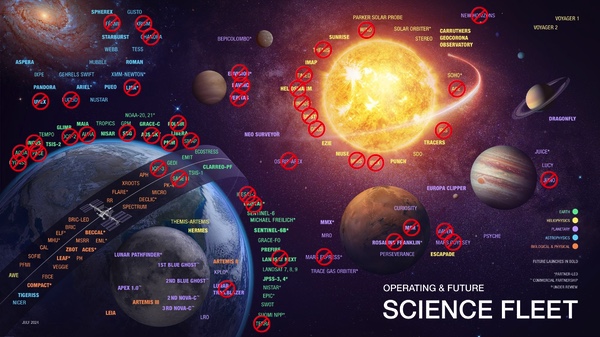 NASA’s science fleet is decimated in the FY 2026 budget proposal. Many ISS instruments would be useless, as the project also cuts nearly all science activities on the ISS and reduces funding for the Microgravity and Biological Science Division by roughly 80%. Source: NASA/Paul Byrne. |
The budget request also cancels planned missions like VERITAS and DAVINCI, our first return to Venus in more than 30 years, before they can even launch. Support for VIPER, the fully-built rover destined to hunt for water-ice deposits at the lunar south pole, is shelved. The Nancy Grace Roman Space Telescope, though not canceled outright as feared, has its funding ratcheted back to less than half the planned amount, lowering the project reserves to levels far below the recommended levels, functionally demanding the project walk an engineering tightrope in the final year of its assembly. If anything goes wrong, the project will miss its launch date and ultimately cost far more than if the reserves had been available at the time they were needed. Planning for the Habitable Worlds Observatory is lowered to nearly zero. And as mentioned, with the halting of nuclear fuel production, the budget request ends a key infrastructure capability painstakingly restored over the course of the past 20 years.
| The proposal undermines its own goals, abandons American leadership, squanders decades of national investment, and destroys the political consensus needed for any great undertaking. |
The frantic and arbitrary nature of this proposal will inevitably create further waste through pure incoherence. You cannot simply fire a third of your workforce, cancel dozens of projects, and expect to pivot seamlessly to the most complex mission humanity has ever attempted. The loss of key personnel, the disruption to the space economy, and the collapse of institutional knowledge will create massive, long-term inefficiencies that will cost the taxpayer far more in the long run.
The budget request is a self-defeating document. It is a budget without a clear, coherent plan. It undermines its own goals, abandons American leadership, squanders decades of national investment, and destroys the political consensus needed for any great undertaking.
The path forward
The damage proposed by the budget request seems all-consuming, but Article I Section 9 prevails. Congress has sole power of the purse, and we have already seen members from both parties, including the chairman of the Senate Commerce Committee and the leadership of the bipartisan Planetary Science Caucus, voice their opposition to the proposed gutting of our domestic space capabilities and scientific preeminence.
For the sake of our nation's future in space, we believe Congress must reject this unprecedented, unstrategic, and wasteful budget and instead forge a bipartisan path forward that maintains a national space program that will continue to lead the world in discovery, innovation, and inspiration. We must invest in a space program that strengthens our economy, supports scientific excellence, advances national interests, and ignites the curiosity of the next generation. Anything less would be a retreat from the responsibility and opportunity that leadership in space demands.
Note: we are now moderating comments. There will be a delay in posting comments and no guarantee that all submitted comments will be posted.
